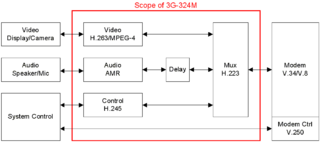| Terminal for low bit-rate multimedia communication | |
| Status | In force |
|---|---|
| Latest version | (04/09) |
| Organization | ITU-T |
| Related standards | G.711, G.722, G.723.1, 3G-324M |
| Website | https://www.itu.int/rec/T-REC-H.324 |
H.324 is an ITU-T recommendation for voice, video and data transmission over regular analog phone lines. It uses a regular 33,600 bit/s modem for transmission, the H.263 codec for video encoding and G.723.1 for audio.

The ITU Telecommunication Standardization Sector (ITU-T) is one of the three Sectors of the International Telecommunication Union (ITU); it coordinates standards for telecommunications and Information Communication Technology.
A voice message is a message containing audio of a person's voice. Voice itself could be 'packaged' and sent through the IP backbone so that it reaches its marked 'address'. In a technical sense, the process of sending 'voice packets' is a semi passive way of communication. However, given the speed at which it could be delivered can make the communication sound seamless.

Video is an electronic medium for the recording, copying, playback, broadcasting, and display of moving visual media. Video was first developed for mechanical television systems, which were quickly replaced by cathode ray tube (CRT) systems which were later replaced by flat panel displays of several types.
Contents
H.324 standard is formally known as Terminal for low bit-rate multimedia communication. H.324 covers the technical requirements for very low bit-rate multimedia telephone terminals operating over the General Switched Telephone Network (GSTN). H.324 terminals provide real-time video, audio, or data, or any combination, between two multimedia telephone terminals over a GSTN voice band network connection.
H.324 terminals offering audio communication shall support the G.723.1 audio codec. H.324 terminals offering video communication shall support the H.263 and H.261 video codecs. G.722.1 may be used for wideband audio applications. Annex G of H.324 specification defines usage of ISO/IEC 14496-1 (MPEG-4 Systems) generic capabilities in H.324 terminals. H.324/I terminals shall support interoperation with voice telephones using G.711 speech coding, if the connected network supports transmission and reception of G.711. Other modes such as G.722 audio may optionally be supported as well. [1]
H.261 is an ITU-T video compression standard, first ratified in November 1988. It is the first member of the H.26x family of video coding standards in the domain of the ITU-T Video Coding Experts Group, and was the first video coding standard that was useful in practical terms.
G.722.1 is a licensed royalty-free ITU-T standard audio codec providing high quality, moderate bit rate wideband (50 Hz – 7 kHz audio bandwidth, 16 ksps audio coding. It is a partial implementation of Siren 7 audio coding format developed by PictureTel Corp.. Its official name is Low-complexity coding at 24 and 32 kbit/s for hands-free operation in systems with low frame loss.
MPEG-4 is a method of defining compression of audio and visual (AV) digital data. It was introduced in late 1998 and designated a standard for a group of audio and video coding formats and related technology agreed upon by the ISO/IEC Moving Picture Experts Group (MPEG) under the formal standard ISO/IEC 14496 – Coding of audio-visual objects. Uses of MPEG-4 include compression of AV data for web and CD distribution, voice and broadcast television applications.
H.324 was adapted by 3GPP to form 3G-324M.
It is for example used in the Vialta Beamer BM-80 Phone Video Station, the MINX system from Datapoint Corporation, and in several other videophones.
